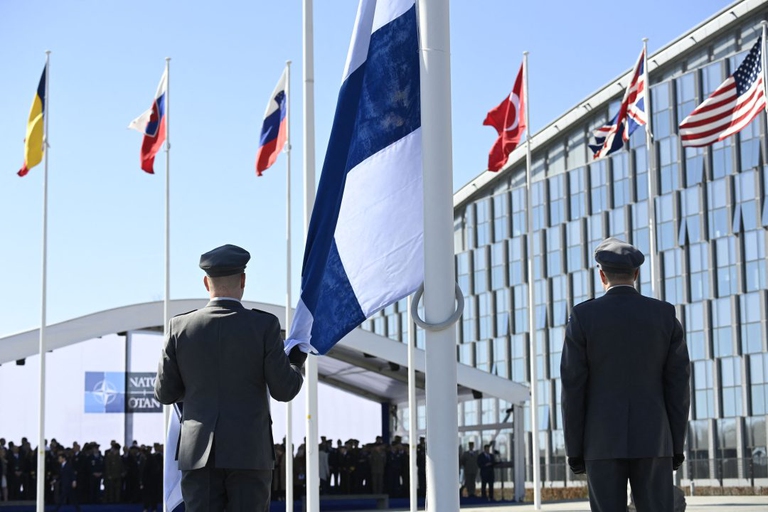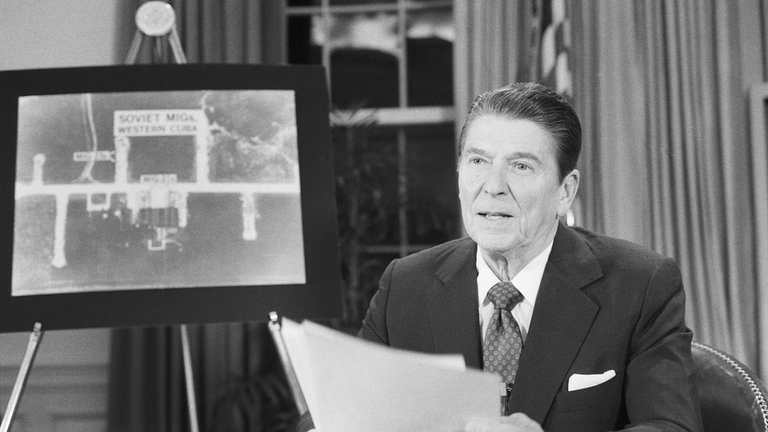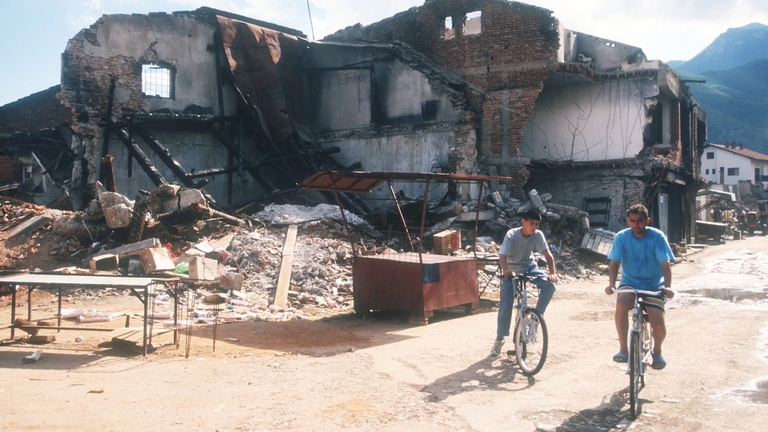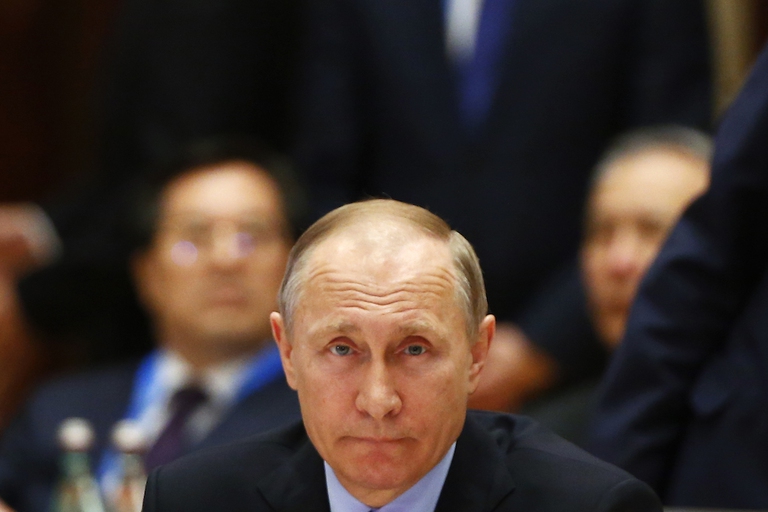https://www.lifegate.it/vertice-nato-75-anni
- |
Nato stands the test of age, as does Joe Biden.The President of the United States welcomed the leaders of the member countries of the Atlantic Alliance yesterday to Washington to celebrate the 75th anniversary of its establishment.The summit it could act as a watershed regarding the future of the alliance's political-military choices and the claims to truly count in global challenges.On the table, obviously, military support forUkraine and its entry, issues on which NATO does not want to back down, as was clear from the statements made on the inaugural day.But what will also count at the summit in these days is what will not be included in the many celebratory speeches that will follow.An unsaid that speaks of a weakened NATO, marked by a history of recurring internal rifts, and which the Russian question alone will not be able to unite.A'institution in existential crisis which, rather than determining new global dynamics, risks being overwhelmed by them.
How the first day of the NATO summit in Washington went
Indiscretions have already arrived on the inaugural day which do not seem to leave room for interpretation.Quoting a Ukrainian official, Politico he anticipated that the member countries will declare that Ukraine's path towards joining the alliance is "irreversible", specifying that the deadline for Kiev's entry into NATO will be put in black and white in the final declaration.Meanwhile, yesterday President Biden gave a direct speech free of the hesitations that have been criticized in recent weeks, in which he argued that "Ukraine can and will stop Putin.Russia will not prevail.Ukraine will prevail."Biden therefore underlined his support for Ukraine, announcing that the United States, Germany, the Netherlands, Romania and Italy will provide Zelensky five Patriot air defense systems in the coming months.A request that had been made by Kiev for some time, but despite this Zelensky immediately defined the Patriot supply as insufficient, adding that "Ukraine immediately needs at least 128 F-16 fighter planes supplied by the West, otherwise it will not be able to able to compete with the Russian Air Force”.
Also speaking yesterday was the outgoing general secretary Jens Stoltenberg, author of an "extraordinary job" in the words of Biden, who, citing the alliance's new annual report on climate change and security, quantified in over 29 billion euros in climate damage caused by the Russian invasion of Ukraine.
In October Stoltenberg will officially hand over the baton to designated secretary Mark Rutte.Former head of government of the Netherlands, conservative leader of liberal orientation, openly pro-market and standard bearer of the "frugal countries" of the European Union for his rigorous line on public finances, Rutte has been able to carve out an important role for himself in national politics and community in the last decade.At the helm of the Netherlands, Rutte has been able to face several crises, strategically forming coalitions from time to time with far-right or reformist parties to maintain the government.It is no coincidence that he was the longest-serving continental leader after Angela Merkel until her exit from the scene in 2021.Not even the scandal that involved him in 2021, forcing him to resign, prevented him from aspiring to the prestigious leadership of NATO, for which he received the fundamental support of the United States, France, the United Kingdom and Germany.
The birth of NATO and Article 5 of the North Atlantic Treaty
The history of the Atlantic Alliance, celebrated in these hours, unfolds throughout the second half of the twentieth century up to the present day.The formal birth of NATO, which took place on 4 April 1949, was the formal act that sanctioned the definitive abandonment of the isolationist policy of the United States towards the West, in the aftermath of the Second World War.Already two years earlier, President Harry Truman had launched the doctrine of containment - or Truman doctrine, precisely - aimed at containing Soviet expansionism in Europe, which in those years was evident above all in Greece and Türkiye.To further speed up the process, in June 1948 the U.S. Senate passed the Vandenberg Resolution allowing the president to enter into common defense agreements with foreign countries.In two years we have arrived at signing of the North Atlantic Treaty, which was joined by the United States, Great Britain, Canada, France, Belgium, the Netherlands, Luxembourg, Portugal, Italy, Norway, Iceland and Denmark.

The document was ratified by national parliaments extremely quickly and not without protests where the communist parties were particularly strong, as in the case of Italy and France.Sweden, invited to participate, refused to preserve its historic neutrality. The initial objectives of the alliance were essentially three:neutralize post-war Germany, directing its institutional reconstruction;defend against the Soviet threat and build a robust bond between the United States and Europe.From a political-military point of view, NATO presented itself as an entity for defensive purposes, as per article 5 of the founding treaty:
“The parties agree that an armed attack against one or more of them, in Europe or North America, must be considered as an attack against all of them and accordingly agree that, if such an armed attack occurs, each of them, in exercise of the right of individual or collective self-defense, recognized by article 51 of the Charter of the United Nations, shall assist the party or parties attacked by immediately taking, individually or in concert with the other parties, such action as it deems necessary, including the use of armed force , to restore and maintain the security of the North Atlantic area”.
The troubled relationship between NATO and France
In 75 years, NATO has become the most pragmatic and concrete symbol of the concept of the West in its twentieth-century version, but nevertheless its history has not been spared from internal frictions linked to the burdens of the participating powers, phases of tension and détente with the external enemy and enlargement processes.In the early 1960s, then French President Charles de Gaulle began a process of divergence from the alliance.De Gaulle, who had helped liberate France from the Nazis thanks to the Allies, was critical of US centrality.He therefore decided to build one independent defense force for his country, which would have allowed him to act autonomously from the Western bloc even in the event of war with the Soviet Union.
In 1966, all French armed forces were removed from NATO's integrated military command, whose troops serving on French soil were asked to leave the country.However, France formally remained in the alliance with the commitment to support NATO in the event of an external attack.In April 2009, France returned to full membership of the organization including re-entry into the NATO military command structure while maintaining, however, an independent nuclear deterrent.
Missile diplomacy during the Cold War
The years preceding the collapse of the Soviet Union in 1991 were characterized by alternating phases of détente and escalation between the blocs.in this phase, as the US choices were mainly motivated by the need to avoid face to face with the Soviet Union, made possible by the proliferation of armaments, in particular medium-range missiles, of those years.After an initial phase of détente under the Nixon presidency, starting from the second half of the seventies a long phase of escalation began which involved the modernization of the missile systems of the two powers, the Soviet invasion of Afghanistan in 1979 and the arrival of Ronald Reagan as president.In this phase the United States considerably increased military spending and started the never-realized program called the Strategic Defense Initiative, which went down in history as the “space shield”, to protect the country from ballistic missile attacks with nuclear warheads.

The aggressive approach towards a Soviet Union now on its last legs pushed the president Mikhail Gorbachev to negotiate with Washington to reduce their respective nuclear and conventional arsenals.A decisive step in this direction occurred in 1990 with the signing of the Start I treaty which provided for a 50 percent reduction in strategic nuclear weapons.With the collapse of the Soviet Union, many scholars expected the alliance to disband, having completed its mission.Instead, NATO found a new raison d'etre by transforming itself from a defensive military alliance into a force for broad political change in Europe, which began with the dissolution of Yugoslavia in the early 1990s.
1999:the bombs on Kosovo
The 1990s meant a long, complex and expensive military commitment for NATO in the Balkans, torn by ethnic wars in the former Yugoslavia.In fact, with the Yugoslav wars between 1990 and 1995, Europe experienced the first armed conflict since the end of the Second World War on its territory, fought in particular between Serbia and Croatia, with Bosnia and Herzegovina as a privileged battleground.But it is from the unprecedented violence of the war in Kosovo that NATO emerged weaker and more controversial.

In March 1999, the then Spanish Secretary General Javier Solana launched theAllied Force operation, which involved a series of bombings on the territories of Serbia and Kosovo.The operation was a military response after Serbian leader Slobodan Milošević – who had begun an operation to “Serbize” Kosovo – had refused to listen to the demands of the international community.The bombings went forward for 78 days, causing an unspecified and never definitively clarified number of civilian victims.The NATO bombs, justified as a "humanitarian intervention", damaged over 300 schools and hospitals, destroyed more than 60 bridges and brought Serbia's infrastructural and industrial system to its knees, causing damage of over 30 billion euros.
The expansion of NATO and tensions with Russia
NATO also undertook a slow and complex process of expansion aimed at entrenching democratic and free market institutions in European nations where communism had retreated.At the 1999 Washington summit, which celebrated NATO's 50th anniversary, the alliance then welcomed the Czech Republic, Poland and Hungary as new members, bringing its number to 19.In 2009, the member countries had become 28, thanks to the global effect of the attacks of 11 September 2021 and the war on terrorism that followed.Among the new members were also Poland and Estonia, who saw NATO mainly as a means to bind the United States to their security in an anti-Russian way, and in this regard they built ties with US special forces and intelligence services.NATO's eastward push became fatal with the 2008 Bucharest summit, when Bush, ignoring the recommendations of his advisors, forced the hand of reluctant European heads of state to promisefuture membership of NATO for Ukraine and Georgia.Russia invaded the latter in the same year, while in 2014 it proceeded with the annexation of Crimea.

It is precisely the events of Georgia and Ukraine that have determined a new direction in the choices of the Atlantic alliance.Over the last decade, the center of gravity of the US national security strategy has progressively moved away from counter-terrorism to embrace a new era of challenges between great powers.For the United States, this means first and foremost China.But for Europeans, it coincided with once again coming face to face with Russia.THE'large-scale invasion of Russia in Ukraine in 2022 and the ongoing war are the prime example.
The summit underway in Washington will be the first to see the participation of Sweden, which joined the alliance in 2023, about a year after Finland.Both have thus abandoned their historic neutrality in the search for greater military protection in an anti-Russian perspective.In strategic terms, the inclusion of Sweden and Finland could be considered a clear victory for the alliance against Moscow, which following the invasion of Ukraine is even more "encircled".NATO has in fact considerably increased its projection to the north-east, also reassuring the Baltic countries and Poland and at the same time eliminating the "buffer" that had been created in that area.“At the level of capacity” – we read from an analysis by ISPI – “Finland and Sweden could make a contribution in terms of air defense.Finland is also one of the few countries to have maintained compulsory military service, thus guaranteeing the country, with its limited population, an important and trained reserve".With the Russian invasion of Ukraine, the support of the citizens of Sweden and Finland for national defense, also foreseen by the Finnish constitution, grew even more.
The late age of the Atlantic Alliance
Over the course of his 75 years NATO has never been immune to crises.The Suez crisis of 1956, the end of the Cold War, the differences with European countries on the intervention in Kosovo and the opposition of France and Germany to Bush's invasion of Iraq are all moments that fueled positions and analysis regarding the end of the alliance.In fact, the end never came.
But today's situation is markedly different than in the past.The forces that are pushing NATO towards “a precipice”, as Stephen Walt wrote about Foreign Affairs, “go beyond the personal inclinations of individual leaders like Trump or Marine Le Pen.”Today, the changed global dynamics are configuring the alliance born on the ashes of the Second World War as an entity rooted in the past, which feels the blows of time like the leaders called to revive it. Today Europe no longer has a key role, neither from a political nor industrial development point of view, overtaken by countries growing at double the speed.
In the meantime, China has come to play openly at the US table:“Today, Asia's share of the world economy is 54 percent, substantially greater than Europe's 17 percent.Its contribution to global economic growth is also greater,” Walt continues.This is not to say that Europe has no importance, but it no longer occupies the place of honor among the strategic interests of the United States.And with Trump on the horizon, this gap could widen further.
